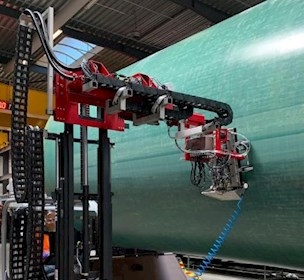P-scan 5 update enables fast, reliable corrosion mapping with automated ultrasonic system
FORCE Technology has developed new software to supplement the already comprehensive software package for the well-known automated ultrasonic P-scan system 5.
The new software offers fast and reliable corrosion mapping scanning of storage tanks, components, storage tanks, pipes, high-pressure vessels, etc. It allows the scanner to move relatively fast by using a relatively low data resolution when collecting ultrasonic data. The ultrasonic data is processed and analyzed on the fly, and different filters and evaluation criteria can be defined.
Improved accuracy
If a measured thickness outside pre-programmed thickness limits is detected, the software controlling the scanner will automatically drive the scanner back to the position in which the measured thickness was outside the specified thickness range and perform additional scanning with higher data resolution (e.g. X1mm x Y1mm) to make sure that the thinnest area is measured and later documented in the report.
An offset may be implemented so that the high-resolution scanning starts X mm before the thickness drops below specified limits and ends X mm after the last x-position in which a thickness below defined limits was measured.
The scanner is usually a magnetic wheel scanner prepared to achieve high speed on the tank's outer surface, but other scanner types may also be used with the software. The maximum speed possible depends on the circumstances, like the outer surface roughness. Scanning is performed from the outer surface to detect corrosion on the inner surface. The tank can remain in service during scanning.
The thickness measurements are usually made with an angle of 0º, and the applied technique is AUT Phased Array. Both A-scans and coloured images (top-, side- and end-views) are displayed for the operator immediately during data collection, and the standard "Error Checker" software performs on-the-fly analysis of the data.
Automated scanner adjusts resolution and generates reports
The analysis is then performed based on the parameters inserted in the software. For example, the nominal thickness of an object can be 15mm steel, and the maximum allowed corrosion rate can be 5mm. So, the operator programmes the error checker to react when the minimum wall thickness of 10mm is measured.
The scanner will then automatically stop and drive back to where the indication started. It will then re-scan the area with a high data resolution from the start of the corroded area to the end of that area. When the corroded area is passed, the scanner will continue at high speed and low data resolution until the next area with corrosion is registered.
In all cases, all readings are stored and available for a complete report after scanning is completed. The report is automatically generated and can consist of both images with thickness shown in different colours for an accessible and illustrative overview. Also, all individual measurements are available, or just the highest and lowest readings if desired.


